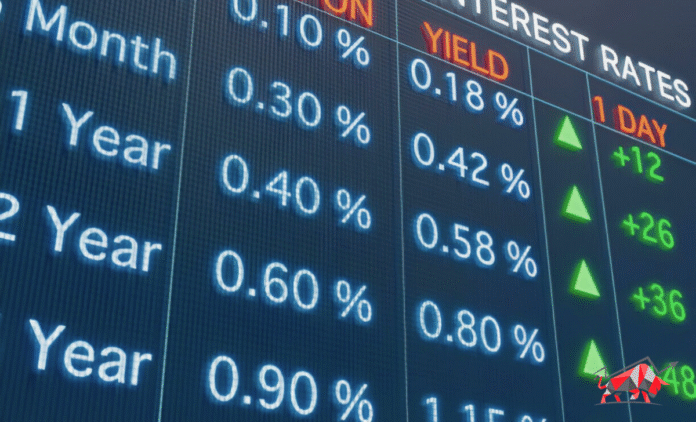The bond market quieted today on renewed optimism over forthcoming Federal Reserve action. Fed Governor Christopher Waller reinforced calls for a rate cut in July, while consumer inflation expectations eased. Stocks remained volatile amid mixed earnings, and President Trump signed landmark stablecoin legislation—a move warmly received by the crypto sector.
Bond Market Braces for Policy Pivot
Short‑dated U.S. Treasuries led bond gains after Governor Waller signalled he may dissent if the Fed declines a rate cut at its July 29–30 meeting. Waller emphasised a weakening labour market and stable inflation expectations as strong justification for easing policy. Meanwhile, University of Michigan data showed one‑year consumer inflation expectations dropped to 4.4 %, down from 5 %, supporting the view that price pressures are subsiding.
Market reaction was swift—yields on shorter Treasuries fell and the dollar eased, though the dollar still posted a modest weekly gain. According to Jeff Roach of LPL Financial: “Investors have something to cheer about with signs of improved inflation expectations”.
Split in the Fed: Waller Versus the Cautious Majority
Waller’s hawkish-to-dovish shift contrasts with key colleagues like Chair Powell and Atlanta’s Austan Goolsbee, who argue that tariffs may still elevate inflation. Waller dismissed those concerns as temporary, suggesting labour market softness offers justification for cutting policy rates now. He proposes a quarter-point reduction in July, with further easing possible depending on data.
Even so, markets remain cautious. As of now, investors still assign near-zero probability to a July rate cut—though about 45 basis points of easing is priced in by year-end, down from over 65 bps earlier this month. Evidence is building, but the Fed majority remains focused on inflation risks.
Related: Federal Reserve at a Crossroads Amid Trump’s Tariffs
Consumer Sentiment Strengthens, Retail Sales Backs Up
Early July data from the University of Michigan showed consumer sentiment at a five-month high, improving from 60.7 to 61.8. Alongside this, U.S. retail sales for June rebounded broadly, easing concerns over a consumer slowdown.
Mark Hackett of Nationwide noted resilience in both macro data and markets, emphasising that this calmness is notable amid a typically hectic news cycle.
Stablecoin Regulation Signed into Law
President Trump signed the GENIUS Act—landmark legislation that creates a regulatory framework for stablecoins backed by safe assets like the U.S. Treasury bills. Industry leaders at the ceremony, including executives from Coinbase, Circle, and Tether, lauded the move, which is expected to bolster stability and innovation in the crypto sector.
This bill could shift crypto-backed demand into Treasury bills, potentially lowering yields further. An academic study estimates that Tether alone held around 1.6 % of U.S. T-bills by Q1 and credited that with a 24 bp yield reduction.
Market Pulse: Earnings and Policy Await
The S&P 500 traded flat as mixed earnings kept investors cautious. So far, 81 % of S&P companies have exceeded earnings estimates—but strong results have not uniformly boosted share prices. As Hackett observed, “the rest of the earnings season will be a key test given elevated valuations and expectations, though with current momentum and sentiment, the path of least resistance is higher”.
The calm before a storm?
The interplay between Fed policy, consumer sentiment and crypto stabilisation is converging. Waller’s push for a July cut is grounded in data, not politics—though it aligns with Trump’s narrative. The drop in inflation expectations offers concrete evidence that easing may be warranted.
Yet reservation remains justified. Inflation is still above target, tariffs may yet exert more pressure, and the Fed’s majority prefers caution.. The risk is that a premature cut could fuel inflation or upset credibility.
On crypto, regulation is stepping in—literal Treasury bill backing could stabilise stablecoins, but it also deepens the link between crypto and traditional finance. Markets will closely watch whether this prompts fresh capital flows into government debt.
In my view, the path ahead is uneven. The data supports cautious optimism—consumer confidence, retail sales, and cooling inflation are heartening. Waller’s stance, echoing a proactive Fed, is warranted given looming labour market softness.
However, the Fed’s principal duty remains inflation control. Acting too soon risks reigniting prices, especially in a politically fraught environment. Meanwhile, the GENIUS Act is a positive step for crypto legitimacy—though its broader market impact depends on execution and adoption.
Ultimately, investors should brace for continued volatility. July may yield a modest policy signal, but the real test lies in the data that arrives between now and September. Growth is solid, sentiment is firm, and markets remain steady—but the Fed’s next moves will be critical in defining what comes next.


